We present for your review and advice a case of Incidental Aneurysm, with no neurological deficit:
- Headache, vascular type
- Two episodes "blind," transitory
- Neurological: normal
- Visual field: normal
- CT and NMR: "Looks like meningioma" (Neurosurgeon opinion)

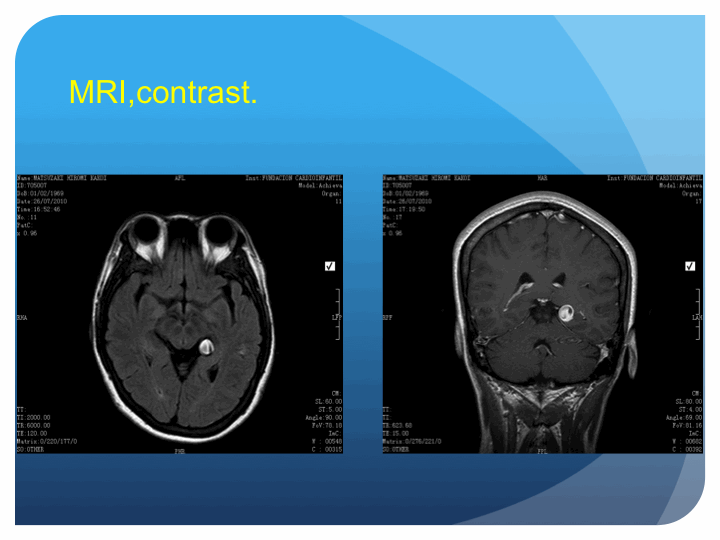
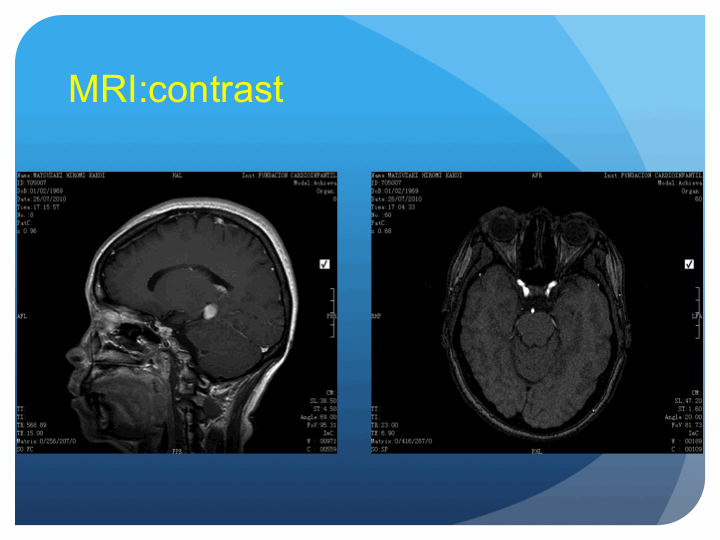
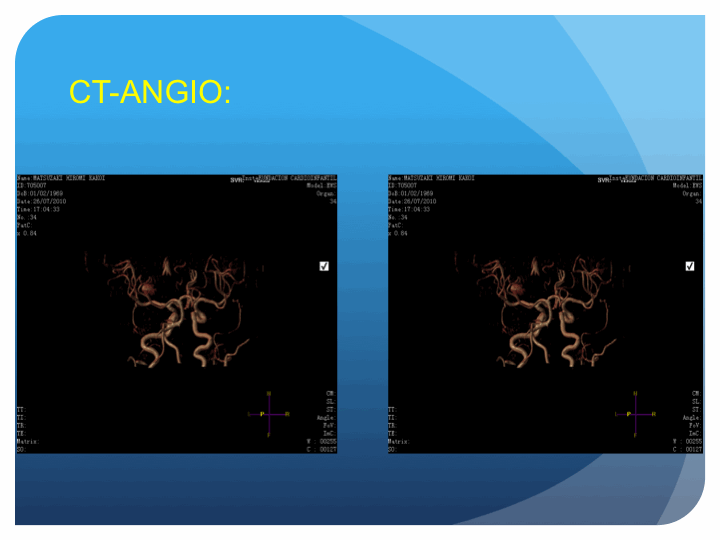
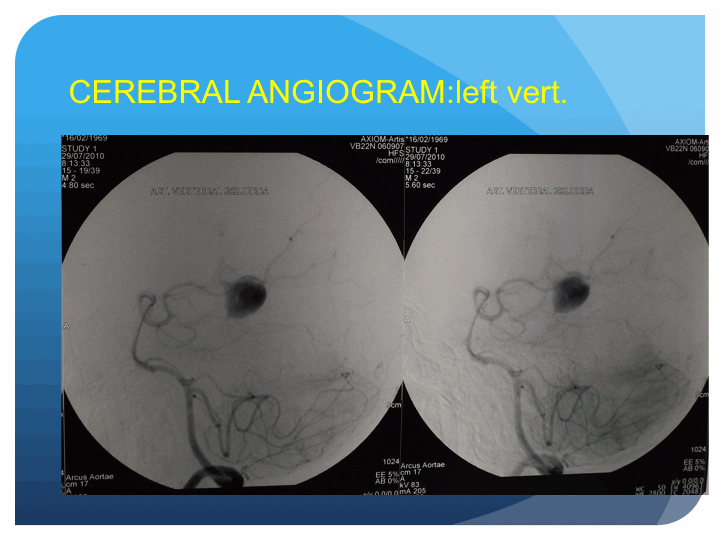
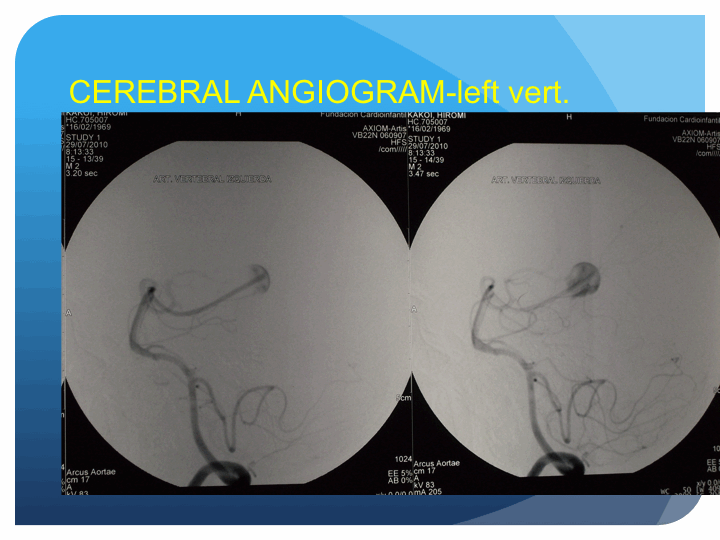

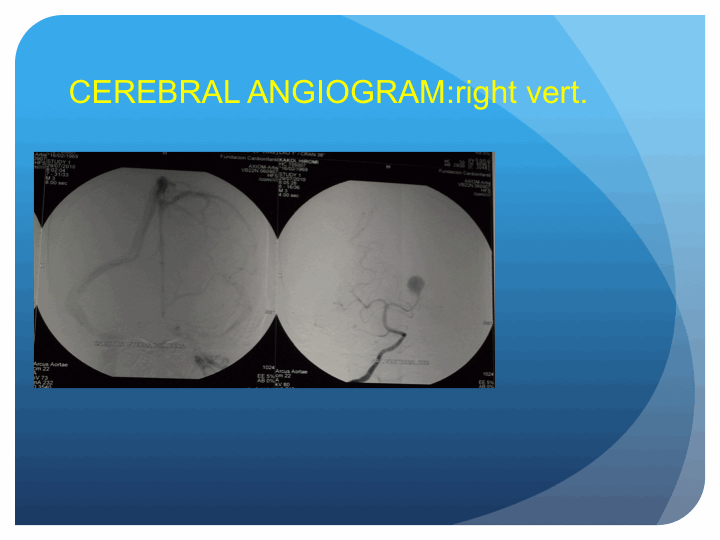
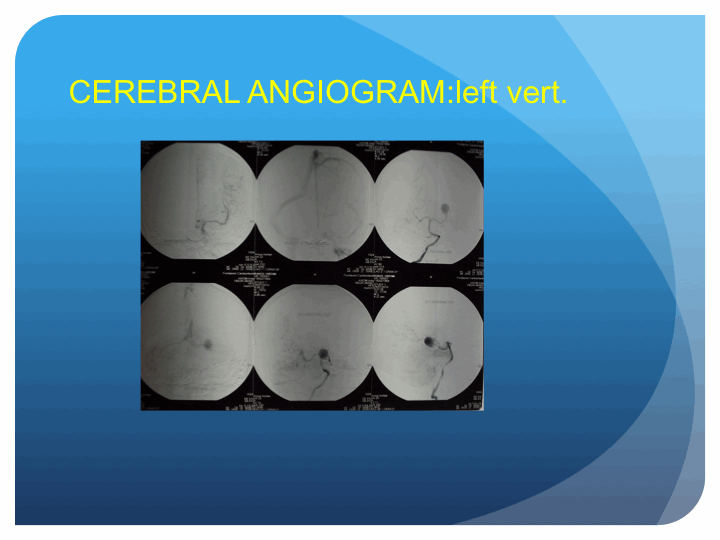
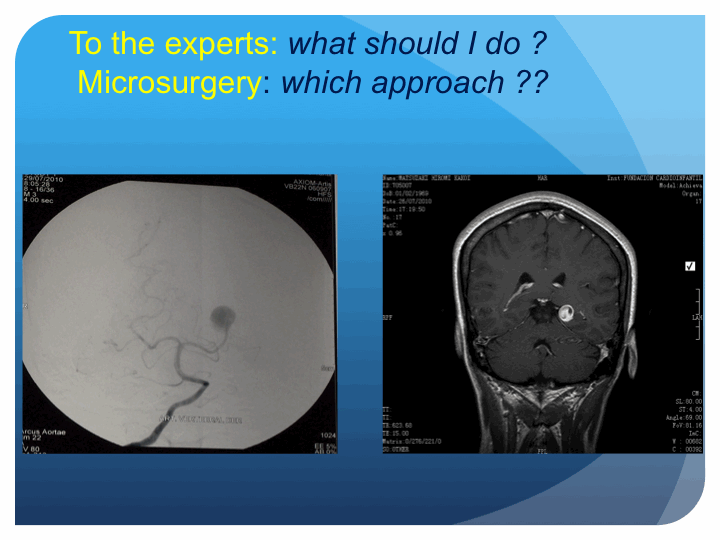 Thank you for your input; it is greatly appreciated.
Remberto Burgos de la Espriella,
Bogota, Columbia
Thank you for your input; it is greatly appreciated.
Remberto Burgos de la Espriella,
Bogota, Columbia









 Thank you for your input; it is greatly appreciated.
Remberto Burgos de la Espriella,
Bogota, Columbia
Thank you for your input; it is greatly appreciated.
Remberto Burgos de la Espriella,
Bogota, Columbia






James Ausman
Posted August 27, 2010, 5:47 pm
Remberto,
This is a challenging case. The lesion is a large or even giant aneurysm in the Ambient Cistern on the left.
First, should it be treated? Its size suggests that it has a higher rate of rupture than smaller aneurysms. The patient also has had symptoms of visual loss “blind”. That suggests the patient did not see in both eyes as opposed to having a homonomous hemianopsia which one would suspect from embolization from this lesion or a seizure. A more detailed history here would help. Assume that there is no history or that it is asymptomatic. I do not know what the headache means. It could be related. But if it is asymptomatic, we need to know the age. I suspect the patient is young which would mean that he would rupture at some point. If not the risks of various treatments must be weighed against the risk of no treatment which would be high over his life time if he is young.
Treatment choices depending upon what is available:
If you have an interventionalist one could consider just occluding the posterior cerebral vessel before the aneurysm. The risk here is infarction of the occipital lobe. However I think I see some collateral from the MCA to the occipital area on that side. A temporary balloon occlusion of the PCA at this level might tell you the risks of occlusion but give no guarantee.
Could the aneurysm be coiled? It has clot in it. an interventionalist could tell you that.
What are the risks of the above treatments. If no homonomous hemianopsia occurred, I would think that with a good interventionalist, the risk would be lower than surgery.
Surgery has two choices as I see it.
One is a subtemporal approach to the PCA. But this is right at the site of the vein of Labbe and retraction on the posterior temporal lobe may produce speech deficits or worse if the Vein is compromised. It would allow control of the proximal portion of the PCA. The mass of the aneurysm would make the surgery more difficult. So this approach, in my opinion has some risks.
Second is a 3/4 prone operated side down occipital transtentorial approach I have written about to the pineal region. A catheter is placed in the left lateral ventricle to drain CSF and allow its collapse. In addition a spinal drain is used to further allow shrinkage of the left brain. The down position also helps as gravity will allow the occipital lobe to fall away from the midline. Mannitol and lasix are given on incision to further shrink the brain. The tentorium is sectioned to the incisura and retracted both medially and laterally. I would have to study the images in more detail to see the location of the lesion but it appears that it is in the ambient cistern and approachable. The problem here is that you will be on the dome of the aneurysm and it will be difficult getting proximal control. However, the risks of this approach are lower than than the first operation in my opinion.
Both procedures have more risk that endovascular coiling if you have a good interventionalist. Occlusion is problematic. Should a bypass be done before the vessel is taken? I think that would be difficult to the peripheral branches of the PCA after the aneurysm.
So, that is my analysis.
Great case!
Jim Ausman
James Ausman
Posted August 27, 2010, 5:59 pm
Remberto,
An additional idea. Assume you do surgery and do the 3/4 prone approach and find the dome of the aneurysm and cannot see the proximal portion. What to do? At that point you could enter the dome of the aneurysm intentionally removing the clot. You will encounter bleeding and a large sucker should control that until you can get a clip on the aneurysm or the PCA. That would allow you more time to dissect and reapply the clip properly.
Jim
Felix Pahl
Posted September 18, 2010, 11:22 pm
Dear Remberto
These is a partly thrombosed, P2p aneurysm, located in the ambient cistern.
First of all in my experience the PCA tolerates very well occlusions and the endovascular approach must be considered. Of course as Dr Ausman has written, a BTO would be better before the occlusion to ensure that no visual loss would occur.
There are two additional approaches to P2p:
1- Transventricular- Transchoroidal – This approach didn’t retract the temporal lobe, but the space you have within the temporal horn and choroid fissure is small and experience with this approach is required.
2- Lateral supracerebellar transtentorial approach – I think these is the best way to approach this area. The patient tolerates very well the cerebellar retraction and you come directly to the ambient cistern. Once you reach the lateral aspect of the midbrain, you may open the tentorium posteriorly to expose the parahyppocampal gyrus and if needed a resection can be done. I have used this route in some cases of aneurysms and tumours of these region with great success.
Felix Pahl
Efren Herrera
Posted February 1, 2012, 8:19 pm
Dr. Burgos,
This is a rare type of aneurysm away from the Willis Polygone and most likely partially thrombosed and forming the blind end of a Posterior Cerebral artery that has never contributed to the irrigation of the occipital lobe. The arteriogram fails to show a branch beyond the aneurysm itself. I have no experience with coiling in this type of aneurysm but I am sure a clip, even a Liga or hemoclip placed just before the aneurysm will suffice to exclude any furhte risk of rupture. Of course you have to be careful with the vein of Labbe and perhaps if would be a good precaution to free it from the archnoid before lifting the temporal lobe. The position of the head to have gravity force in your favor is also important.
Efren Herrera, Puebla, Mexico